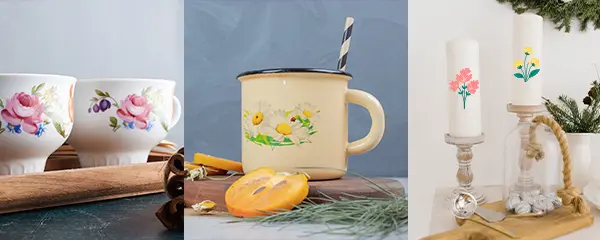
Why is my Infusible Ink not transferring to my mug?
2024-10-25
Are waterslide decals better than stickers?
2024-11-01Water transfer decals bring an exceptional level of customization to a variety of projects, from home décor to personalizing items like mugs and glassware. These decals are celebrated for their intricate designs, flexibility, and vibrant colors. But one essential question that often arises is, “How long do waterslide decals last?” The lifespan of these decals can vary depending on several key factors, including the quality of materials, application techniques, and maintenance practices. Here, we’ll explore in detail how long you can expect your waterslide decals to last, as well as tips to extend their longevity.
What are Water Transfer Decals?
Water transfer decals are thin, paper-based designs that adhere to surfaces when activated by water. These decals are incredibly versatile, allowing for applications on a wide range of materials, such as ceramics, glass, metal, and even wood. Typically, the decals are printed on a specialized paper that has a water-soluble adhesive, which makes it possible to transfer the design smoothly onto the desired surface. They are especially popular among crafters, DIY enthusiasts, and businesses seeking a professional finish on their products.
Factors That Influence the Lifespan of Water Transfer Decals
The longevity of a waterslide decal depends on multiple factors, including the type of decal paper used, the quality of the printed design, and the method of application. Below, we delve into the primary factors that affect the durability of these decals:
1. Quality of Decal Paper
The type of water transfer decal paper you choose plays a major role in the lifespan of your waterslide decal. There are generally two types of waterslide decal paper available:
Inkjet Waterslide Decal Paper: Suitable for inkjet printers, this paper type requires a clear acrylic spray coating to protect the ink.
Laser Waterslide Decal Paper: Ideal for laser printers, this paper does not require an additional sealant because the toner itself is waterproof.
Laser waterslide decals typically last longer due to the waterproof nature of laser toner. However, even with inkjet decals, a high-quality sealant can enhance durability.
2. Type of Surface Applied To
Waterslide decals can be applied to a variety of surfaces, but certain materials will influence their longevity. For example, decals applied to:
Glass: Generally last longer on glass, especially if not exposed to harsh chemicals or frequent washing.
Ceramics: Decals applied to ceramics can last well if placed in areas with limited handling and careful washing practices.
Wood and Metal: While water transfer decals can adhere to these surfaces, they may wear more quickly due to the surface texture and potential exposure to elements.

Applicable surface
3. Application Technique
The process of applying waterslide decals can directly affect how well they adhere to the surface and, ultimately, how long they last. Here are a few key application tips that can significantly improve the durability of your decals:
Clean the Surface: Always clean the surface thoroughly before applying the decal to remove any dust or oils.
Use a Sealant: After the decal is dry, applying a clear acrylic sealant can enhance its resistance to water and wear.
Allow Proper Drying Time: Let the decal dry completely before handling or using the item. Ideally, give it 24 hours for full adhesion.
4. Exposure to Elements
Exposure to water, heat, and sunlight can shorten the lifespan of waterslide decals. For example, decals on items frequently washed, such as mugs or plates, may begin to peel or fade over time. If you’re planning to use waterslide decals on outdoor items or pieces exposed to direct sunlight, consider using a UV-resistant clear coat to protect against sun damage.
Estimated Lifespan of Water Transfer Decals on Common Items
The expected lifespan of a waterslide decal varies by item and usage. Here is an overview of typical lifespans for common applications:
1. Mugs and Glassware
Waterslide decals on mugs and glassware can last anywhere from 6 months to 2 years with regular use. Hand-washing is recommended, as dishwashers may cause the decal to peel prematurely. For best results, apply an epoxy or resin coating over the decal to make it more resilient.
2. Decorative Plates and Ceramics
Decorative plates and ceramics can hold up for several years if they are not used for food and are displayed in a low-contact area. When used as decoration, decals can last up to 5 years or more with minimal maintenance.
3. Phone Cases and Electronics
For items like phone cases, waterslide decals may start to show signs of wear within 6-12 months, as these surfaces are frequently touched. To improve longevity, apply a clear protective coating or consider using a case cover that shields the decal.
4. Car Models and Model Trains
Waterslide decals applied to model vehicles and trains can last for several years if they are kept indoors and away from moisture. Models displayed in cases or used only occasionally have a much longer lifespan, often exceeding 10 years.
how to use laser white water decal slide transfer paper on ceramic tiles?
Tips to Extend the Lifespan of Water Transfer Decals
Ensuring that your waterslide decals last as long as possible requires careful application and a few maintenance steps. Here are our top tips to maximize durability:
1. Use a High-Quality Sealant
After applying the decal, finish it with a quality clear acrylic or epoxy sealant. This layer not only waterproofs the decal but also protects it from scratches and fading.
2. Limit Exposure to Water and Heat
Although waterslide decals are water-activated, they are not entirely waterproof. Minimize exposure to water, especially hot water, to avoid premature peeling or fading. For items like mugs or plates, hand-wash gently with mild soap and avoid abrasive sponges.
3. Store Items with Care
For items with decals that aren’t in regular use, consider storing them in a cool, dry place. Avoid stacking objects with decals on top of one another, as pressure can cause the decal to crack or peel over time.
4. Apply UV-Resistant Coating for Outdoor Use
If you’re using waterslide decals on items exposed to sunlight, such as outdoor planters or car decals, applying a UV-resistant spray can significantly extend their lifespan. This additional layer of protection minimizes the risk of fading due to sun exposure.
Common Issues with Water Transfer Decals and How to Avoid Them
While waterslide decals are generally straightforward to apply, a few common issues can arise. Understanding these issues and their solutions can help ensure your decals look professional and last longer:
Peeling: If the decal starts peeling soon after application, it may be due to insufficient drying time or lack of sealant. Allow the decal to cure fully and always apply a topcoat.
Fading: Fading is common with exposure to sunlight or water. Using a UV-protectant spray and limiting water exposure can help preserve vibrant colors.
Air Bubbles: Air bubbles can form during application, impacting adhesion. Use a soft cloth to smooth out the decal gently, ensuring there are no trapped air pockets.
Conclusion: Maximizing the Lifespan of Your Waterslide Decals
The lifespan of waterslide decals can vary widely depending on factors such as surface material, application quality, and maintenance practices. By following proper application techniques and using sealants, you can enjoy your waterslide decals for years to come. Whether on glassware, model trains, or ceramics, these tips will help you preserve the beauty and vibrancy of your decals.
Waterslide decals offer an affordable and effective way to personalize items. With mindful care, these decals can continue to enhance your creations, bringing color, style, and personality to a variety of surfaces.
Related:
Is Waterslide Decal Paper Permanent?
Choosing the Perfect Waterslide Decal Paper
Best Waterslide Decal Paper for Inkjet Printers

